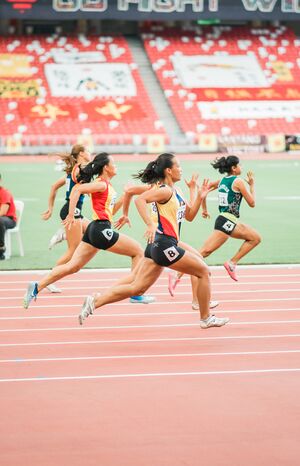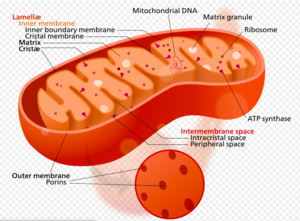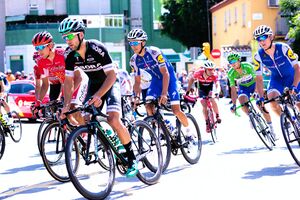Endurance Exercise: Difference between revisions
No edit summary |
No edit summary |
||
| Line 18: | Line 18: | ||
== Types of Endurance Exercise == | == Types of Endurance Exercise == | ||
[[File:Runners.jpeg|right|frameless]] | |||
Endurance exercise means a general ability to do any kind of physical activity that increases your heart rate above 50% of your maximum. It can be divided into general endurance and specific endurance. | Endurance exercise means a general ability to do any kind of physical activity that increases your heart rate above 50% of your maximum. It can be divided into general endurance and specific endurance. | ||
Revision as of 06:08, 25 November 2021
Original Editor - Lucinda hampton
Top Contributors - Lucinda hampton, Oyemi Sillo and Aminat Abolade
Introduction[edit | edit source]
In sport, endurance is the ability to sustain a specific activity (endurance running, cycling, swimming, rowing, cross-country skiing etc) for a prolonged period.
- An endurance sport is any sport in which there is a requirement to sustain an activity level while enduring a level of physical stress.
- Endurance training involves developing both general and event specific endurance. And the mental toughness or “grit” needed to achieve our peak performance.
- The fundamental requirement for any endurance sport is the ability to sustain a submaximal work rate for a prolonged period.
The ability to compete strongly in endurance events is influenced by our physical fitness and psychological strengths
- Endurance training is largely influenced by physiological factors (efficiency of energy systems, aerobic capacity/VO2 max, lactate threshold, muscle strength, power and muscular endurance) and Neuromuscular Adaptations to Exercise. See also exercise physiology
- Psychology also plays a key part in success in endurance sport.[1]
Types of Endurance Exercise[edit | edit source]
Endurance exercise means a general ability to do any kind of physical activity that increases your heart rate above 50% of your maximum. It can be divided into general endurance and specific endurance.
- Specific endurance is the ability to stand against fatigue in sport specific conditions. The better the sport specific endurance, the better performance at this specific sport. It can be characterised as a combination of various types of endurance needed to maximise the ability to succeed in the discipline. eg, if you’re a 1500m runner, you use a combination of endurance training methods to perform better at your specific distance.
- General endurance characterises the ability of the whole body to tolerate endurance exercises and diminish fatigue. The better your general endurance the better you can stand longer efforts at various sports disciplines. eg, if you are a 30 km cyclist have high level general endurance, you can perform at a relativly high level also at 100km, but you can’t compete with 100 km cyclists who have been developing their distance specific endurance[2].
New Insights[edit | edit source]
The effect of exercise training on muscle phenotype has been appreciated for millennia. In general, individuals who train by exercising for a long time will develop better oxygen delivery to muscle and endurance capacity, whereas those who work against a heavy load will get bigger and stronger muscles. However, recent work using high-intensity short-duration interval training to increase endurance and low-load resistance training to failure to increase muscle size and strength have challenged the classical view of training specificity.[3]
High intensity interval training (HIIT)
- a highly desirable workout, because it engaging all muscle fibers, the fast twitch as well as the slow twitch. This makes anaerobic (HIIT) good for a complete training effect.
- The benefits from anaerobic (HIT) exercise depend on the effort put in. Maximum “effort” by a large muscle mass, such as the legs, produces optimum benefits for the whole body.
- Typically, a HIIT workout will range from 10 to 30 minutes in duration[4].
Mitochondrial Biogenesis[edit | edit source]
Endurance training leads to adaptations in both the cardiovascular and musculoskeletal system that supports an overall increase in exercise capacity and performance. The local adaptations in skeletal muscle, such as increased mitochondrial biogenesis and capillary density, aid in the body’s ability to transport and use oxygen to generate energy and therefore delay the onset of muscle fatigue during prolonged aerobic performance. The mitochondrion is the main organelle for energy production through the generation of adenosine triphosphate (ATP) via the electron transport system, using substrates generated in the tricarboxylic acid (TCA) cycle.[3]
The Role of Supplements[edit | edit source]
The world of endurance nutrition is continually evolving and the commercial supplement industry is ever-changing. New products with purported benefits are being advertised to athletes as well as the general population, claiming improvements in performance and general health. Elite athletes, after they maximize training adaptations, often look to gain marginal benefits that they believe may be pivotal in their results. While it is recommended that athletes obtain nutrition from whole foods, we acknowledge that athletes may take supplements and recommend they choose from trusted sources. Below summarises the key recommendations for macronutrients, hydration, and supplements.
- High carbohydrate diets have long been tested and continues to be recommended in endurance athletes. Most endurance athletes are familiar with high carbohydrate diets, but the importance of protein (both total daily intake and immediate post-exercise consumption) may not be as well-known by athletes. Attention to adequate intake is emphasized to improve recovery, ameliorate muscle damage, and maintain muscle mass.
- Fats recently have been gaining popularity again, especially with ultra-endurance athletes.
- There has been a shift away from forced hydration plans and personalizing fluid intake according to thirst and sweat rates to avoid exercise-associated hyponatremia.
Athletes commonly take supplements, and a few supplements may have merit in the endurance world.
- Nitrates are a vasodilator. Vasodilators widen (dilate) the blood vessels, improving blood flow and allowing more oxygen-rich blood to reach the heart muscle. They may help reduce oxygen cost and improve time to exhaustion, possibly cardiorespiratory performance at anaerobic threshold, and even VO2max. Studies are mixed however, and nitrate may preferentially benefit non-elite recreational athletes.
- Antioxidants may help an athlete who has already peaked in terms of training adaptation, where the main goal is facilitating recovery and earlier return to competition in multi-stage events.
- Caffeine has a very large body of research behind its ergogenic effects, with side effects being the main limiting factor[5].
References[edit | edit source]
- ↑ Training for endurance What is endurance? Available: https://training4endurance.co.uk/physiology-of-endurance/what-is-endurance/(accessed 25.11.2021)
- ↑ Blogsportlyzer Types of Endurance Training Explained Available: https://blog.sportlyzer.com/en/types-of-endurance-training-explained/ (accessed 25.11.2021)
- ↑ 3.0 3.1 Hughes DC, Ellefsen S, Baar K. Adaptations to endurance and strength training. Cold Spring Harbor perspectives in medicine. 2018 Jun 1;8(6):a029769. Available:https://www.ncbi.nlm.nih.gov/pmc/articles/PMC5983157/ (accessed 25/11/2021)
- ↑ Healthline Anaerobic Exercise Available from: https://www.healthline.com/health/fitness-exercise/anaerobic-exercise#types (accessed 25.11.2021)
- ↑ Vitale K, Getzin A. Nutrition and supplement update for the endurance athlete: review and recommendations. Nutrients. 2019 Jun;11(6):1289.Available:https://www.ncbi.nlm.nih.gov/pmc/articles/PMC6628334/ (accessed 25.11.2021)












